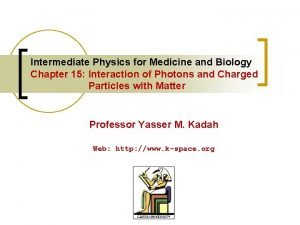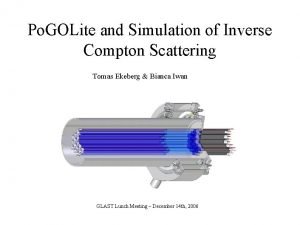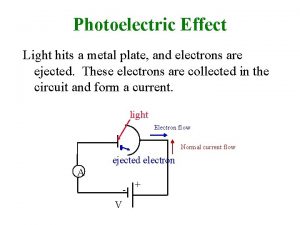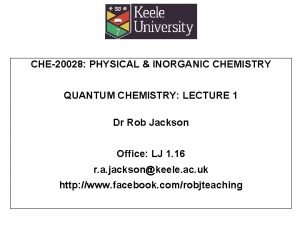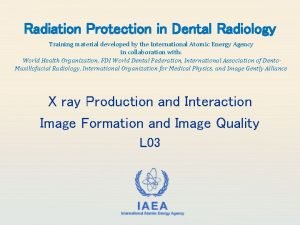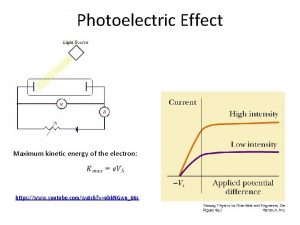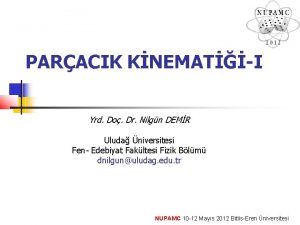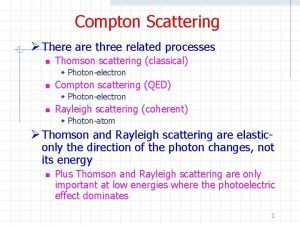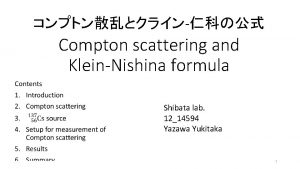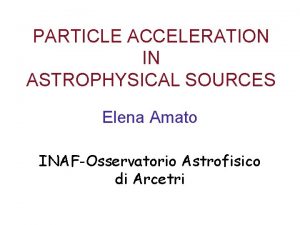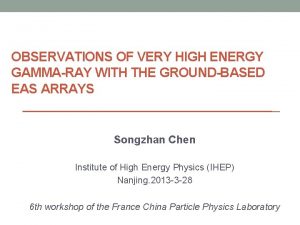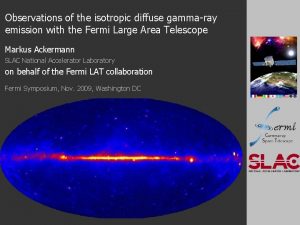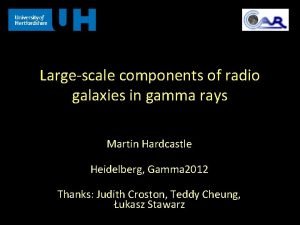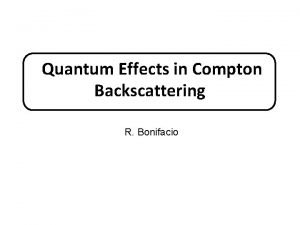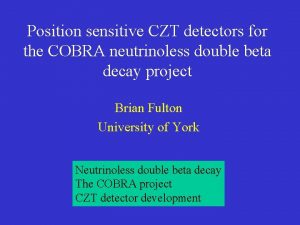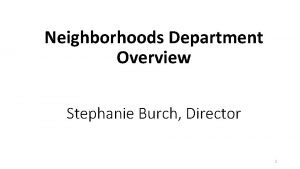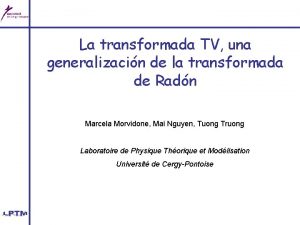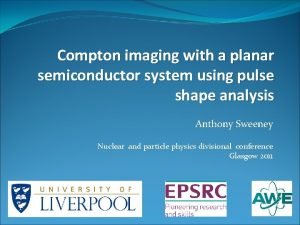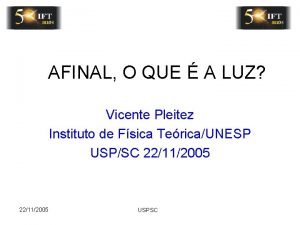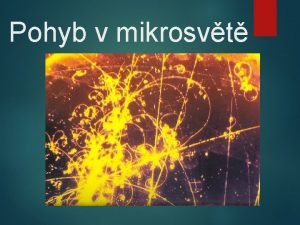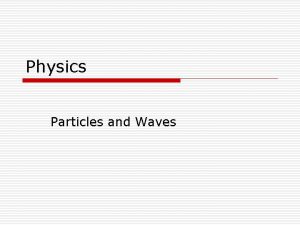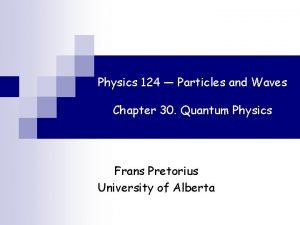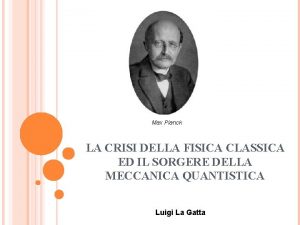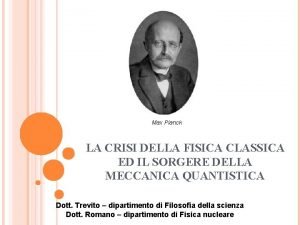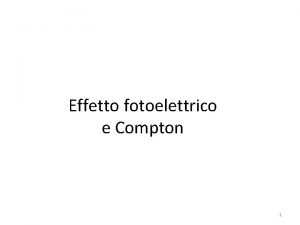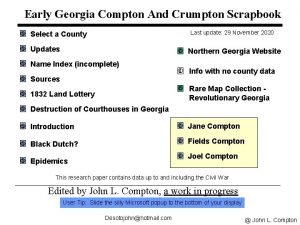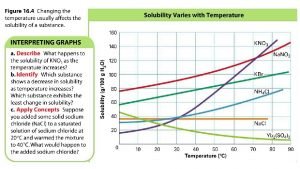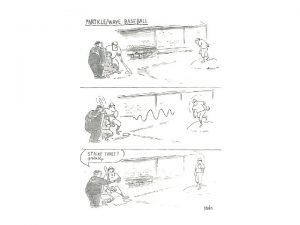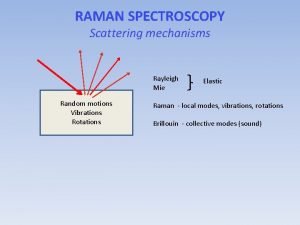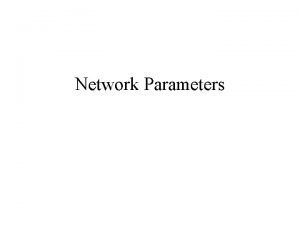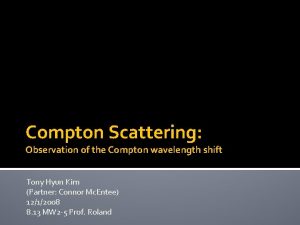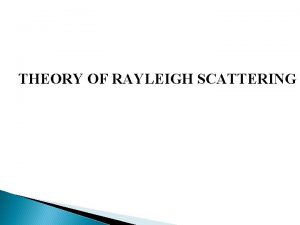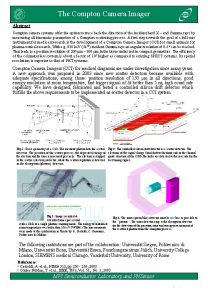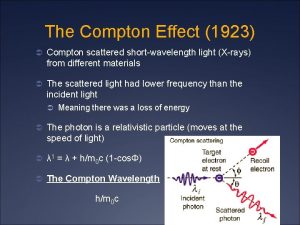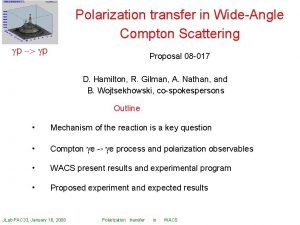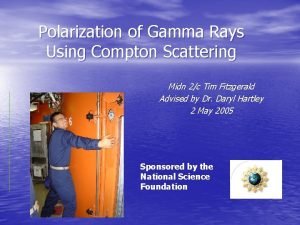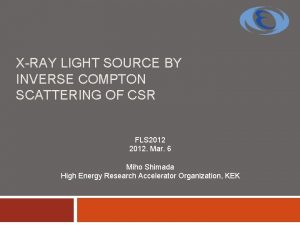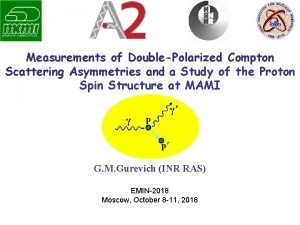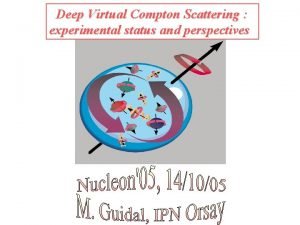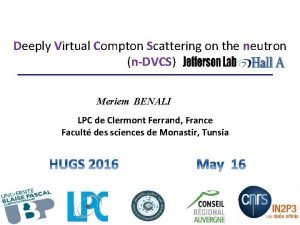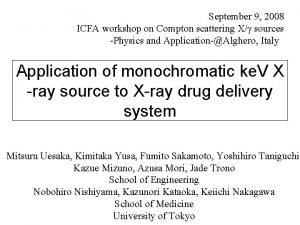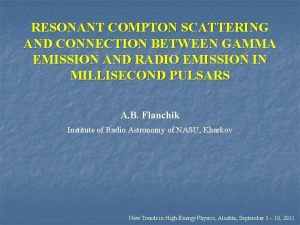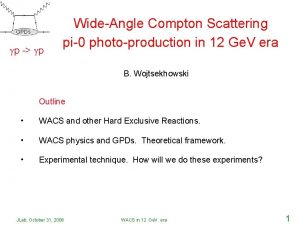Compton Scattering There are three related processes n


















































- Slides: 50

Compton Scattering Ø There are three related processes n Thomson scattering (classical) w Photon-electron n Compton scattering (QED) w Photon-electron n Rayleigh scattering (coherent) w Photon-atom Ø Thomson and Rayleigh scattering are elastic- only the direction of the photon changes, not its energy n Plus Thomson and Rayleigh scattering are only important at low energies where the photoelectric effect dominates 1

Thomson Scattering Ø In Thomson scattering an electromagnetic (EM) wave of frequency f is incident on an electron n What happens to the electron? Ø Thus the electron will emit EM waves of the same frequency and in phase with the incident wave Ø The electron absorbs energy from the EM wave and scatters it in a different direction Ø In particular, the wavelength of the scattered wave is the same as that of the incident wave 2

Thomson Scattering 3

Rayleigh Scattering Ø Rayleigh scattering is scattering of light from a harmonically bound electron Ø You may recall the probability for Rayleigh scattering goes as 1/λ 4 n Why is the sky blue? 4

Compton Scattering ØCompton scattering is the scattering of light (photons) from free electrons 5

Compton Scattering Ø Calculations Ø The change in wavelength can be found by applying n Energy conservation n Momentum conservation 6

Compton Scattering Ø From energy conservation Ø From momentum conservation Ø Eliminating pe 2 7

Compton Scattering Ø Continuing on Ø And using v=c/λ we arrive at the Compton effect Ø And h/mc is called the Compton wavelength 8

Compton Scattering Ø Summarizing and adding a few other useful results are 9

Compton Scattering Ø The differential and total cross sections are calculated in a straightforward manner using QED n Called the Klein-Nishina formula 10

Compton Scattering Ø On the previous slide Ø At low energies Ø At high energies 11

Compton Scattering Ø Thus at high energies, the Compton scattering cross section s. C goes as 12

Compton Scattering ØGraphically, ds/d. W 13

Compton Scattering ØIn polar form, assume a photon incident from the left 14

Compton Scattering ØAt high energies, say > 10 Me. V, most of the photons are scattered in the forward direction ØBecause of the high forward momentum of the incident photons, most of the electrons will also be scattered in the forward direction 15

Compton Scattering ØConcerning kerma and absorbed dose, we are particularly interested in the scattered electron because it is ionizing ØWe can split the Compton cross section into two parts: one giving the fraction of energy transferred to the electron and the other the fraction of energy contained in the scattered photon 16

Compton Scattering 17

Compton Scattering Here sen=str 18

Compton Scattering Ø Another useful form of the differential cross section is ds/d. T, which gives the energy distribution of the electron 19

Compton Scattering Ø The maximum electron kinetic energy is given by 20

Compton Scattering ØIn cases where the scattered photon leaves a detector without interaction one would observe 21

Compton Scattering 22

Compton Scattering 23

Pair Production ØPair production is the dominant photon interaction at high energies (> 10 Me. V) ØIn order to create a pair, the photon must have > 2 me = 1. 022 Me. V ØIn order to conserve energy and momentum, pair production must take place in the Coulomb field of a nucleus or electron n n For nuclear field, Ethreshold > 2 x me For atomic electron field, Ethreshold> 4 x me 24

Pair Production 25

Pair Production Ø Energy and momentum conservation give Ø Energy conservation can be re-written Ø But momentum conservation (x) shows Ø Thus energy and momentum are not simultaneously conserved 26

Pair Production ØThe processes of pair production and bremsstrahlung are related (crossed processes) n Thus we’d expect the cross section to depend on the screening of atomic electrons surrounding the nucleus w Does the photon see nuclear charge Ze or 0 or something in between? n The relevant screening parameter is 27

Pair Production Ø In the Born approximation (which is not very accurate for low energy or high Z) one finds 28

Pair Production ØNotes n n spair ~ Z 2 Above some photon energy (say > 1 Ge. V), spair becomes a constant In order to account for pair production from the Coulomb field of atomic electrons, Z 2 is replaced by Z(Z+1) approximately since the cross section is smaller by a factor of Z Usually we don’t distinguish between the source of the field 29

Pair Production ØNotes n In the case of the nuclear field and for large photon energies, the mean scattering angle of the electron and positron is 30

Pair Production ØThe probability for pair production 31

Pair Production Ø 2 me (1. 022 Me. V) of the photon’s energy goes into creating the electron and positron Ø The electron will typically be absorbed in a detector Ø The positron will typically annihilate with an electron producing two annihilation photons of energy me (0. 511 Me. V) each Ø If these photons are not absorbed in the detector than the pair production energy spectrum will look like 32

Pair Production 33

Pair Production Ø Similar to the photoelectric effect and Compton scattering we define the mass attenuation and mass energy transfer coefficients as 34

Photonuclear Interactions ØHere a nucleus is excited by the absorption of a photon, subsequently emitting a neutron or proton ØMost important when the energy of the photon is approximately the binding energy of nucleons (5 -15 Me. V) n n Called giant nuclear dipole resonance Still a small fraction compared to pair production however 35

Photonuclear Interactions Ø Giant dipole resonance 36

Photonuclear Interactions ØThese interactions would be observed with higher energy x-ray machines n n A 25 MV x-ray beam will contain neutron contamination from photonuclear interactions Small effect compared to the photon beam itself ØAlso important in designing shielding since ~Me. V neutrons are difficult to contain 37

Photon Interactions ØTypical photon cross sections 38

Photon Interactions ØTypical photon cross sections 39

Photon Interactions Ø Notes n n Of course different interactions can occur at a given photon energy A polyenergetic beam such as an x-ray beam is not attenuated exponentially w Lower energy x-rays have higher attenuation coefficients than higher energy x-rays w Thus the attenuation coefficient changes as the beam proceeds through material w An effective attenuation length meff can be estimated as 40

Beam Hardening 41

Photon Interactions Ø Let’s return to our first slide Ø As we’ve seen in the different photon interactions n n Secondary charged particles are produced Photons can lose energy through Compton Ø We define n Narrow beam geometry and attenuation w Only primaries strike the detector or are recorded n Broad beam geometry and attenuation w All or some of the secondary or scattered photons strike the detector or are recorded w Effective attenuation coefficient m’ < m 42

Photon Interactions 43

Photon Interactions ØIn ideal broad beam geometry all surviving primary, secondary, and scattered photons (from primaries aimed at the detector) is recorded n In this case m’ = men 44

Photon Interactions Ø There are three relevant mass coefficients 45

Photon Interactions Ø Tables of photon cross sections, mass attenuation, and mass-energy absorption coefficients can be found in numerous places n n n http: //physics. nist. gov/Phys. Ref. Data/contents. html NIST also gives material constants and composition Useful since 46

Photon Interactions l=1/(m/r) 47

Photon Interactions Ø Sometimes easy to loose sight of real thickness of material involved 48

Photon Interactions ØX-ray contrast depends on differing attenuation lengths 49

Photon Interactions Ø What is a cross section? Ø What is the relation of m to the cross section s for the physical process? 50
 Photoelectric and compton effect
Photoelectric and compton effect Conservation of momentum
Conservation of momentum Compton scattering
Compton scattering Photoelectric effect สรุป
Photoelectric effect สรุป Compton scattering
Compton scattering Insidan region jh
Insidan region jh Concurrent processes are processes that
Concurrent processes are processes that Physical fitness two types
Physical fitness two types Health related skill
Health related skill Compton scatter radiology
Compton scatter radiology Www.youtube.com
Www.youtube.com Compton saçılması
Compton saçılması Compton olayi
Compton olayi Photoelectric and compton effect
Photoelectric and compton effect Gammra
Gammra Pion decay
Pion decay Inverse compton
Inverse compton Inverse compton
Inverse compton Ngc 6251
Ngc 6251 Youth wildcat offense
Youth wildcat offense Hiệu ứng compton
Hiệu ứng compton Compton backscattering
Compton backscattering James dewey watson y francis harry compton crick
James dewey watson y francis harry compton crick Rayos
Rayos Efecto compton
Efecto compton Bad sight
Bad sight Stephenie compton email
Stephenie compton email Efecto compton
Efecto compton Compton
Compton Efeito fotoelétrico einstein
Efeito fotoelétrico einstein Arthur compton experiment
Arthur compton experiment Wavesap
Wavesap Compton wavelength
Compton wavelength Crisi fisica classica
Crisi fisica classica Effetto compton
Effetto compton Compton
Compton Victorian curriculum economics
Victorian curriculum economics Bohr atom modeli formülleri
Bohr atom modeli formülleri Effetto fotoelettrico
Effetto fotoelettrico Gwinette county court
Gwinette county court When manipulating the scalp during a shampoo
When manipulating the scalp during a shampoo How to plot zimm plot in excel
How to plot zimm plot in excel Scattering of light in suspension
Scattering of light in suspension Scattering in a central force field
Scattering in a central force field It is the scattering of light
It is the scattering of light Rayleigh scattering formula
Rayleigh scattering formula Mie scattering vs rayleigh
Mie scattering vs rayleigh Coherent scattering
Coherent scattering Scattering cross section in nuclear physics
Scattering cross section in nuclear physics Abcd short
Abcd short Liquid crystal display
Liquid crystal display

